Showing all posts tagged travel:
Take Pride.
Obviously, I have not been blogging much lately. This is a good sign, inasmuch as the new gig is going well and keeping me ridiculously busy.
Another sign of the job going well and me being busy is that I have been spending a lot of time in aeroplanes lately. I have yet to beat my personal record of four flights in one day (LIN-CDG-CPH-CDG-LIN, since you ask) but I haven’t been idle either.
As you fly more, you start to notice and appreciate the little things: which airline has the better app, which airport is easiest to get around, and so on. European airlines (at least national carriers) still do decent on-board service too, which leads me to today’s observation.
I was on Lufthansa, and was served this beer:
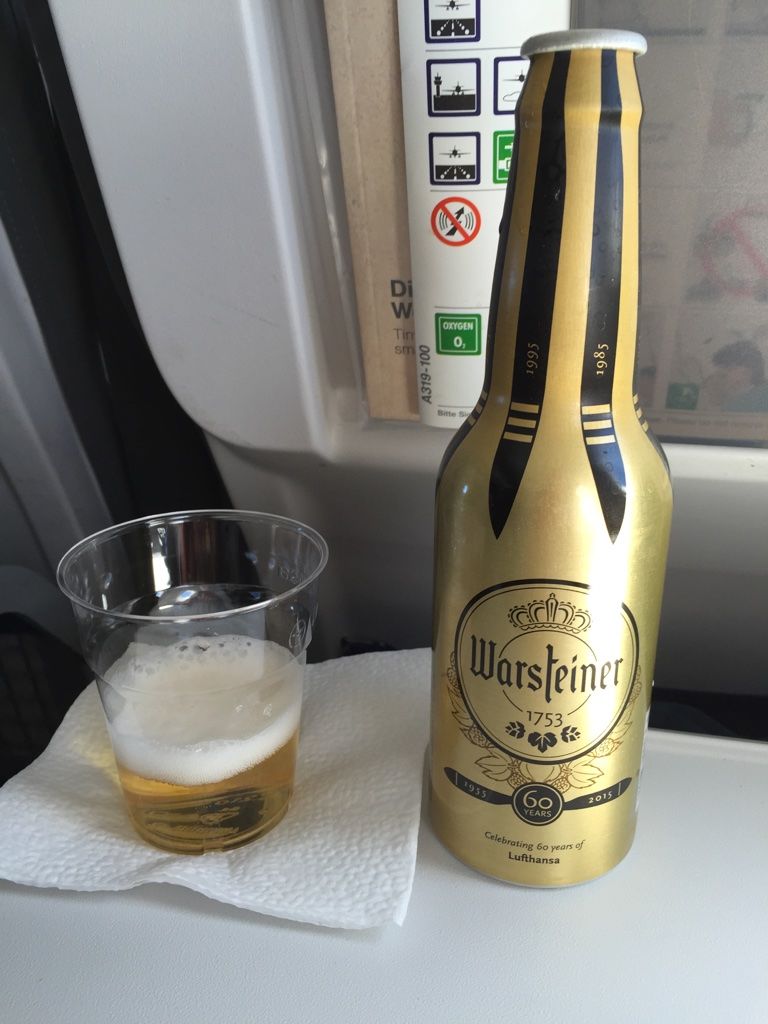
First off, it’s the perfect beer to serve: it’s a Warsteiner, so a good German beer on a German airline. I also like the aluminium bottle celebrating Lufthansa specifically. An aluminium bottle is clever for an airline, since the material is much lighter than glass, and I believe may also help extend the shelf life of the beer, while the bottle still seems more "premium" than a can.
Lufthansa is one of my two main airlines; the other is British Airways1, and the contrast in their beer policies is instructive. It’s certainly a missed opportunity when the cabin crew respond to a request for a beer with "Heineken or Tiger?". This hardly helps British beers’ reputation abroad…
It’s all the more puzzling since BA is quite happy to stock London Pride in their (excellent) lounges. Why not stock that on board, with one lager as an alternative for wrong-headed people who prefer that, instead of the indistinguishable choice between two non-British lagers?
-
One of the downsides of living in Italy is the lack of a decent airline, or a true hub airport for that matter. Almost any even medium-haul trip is multi-stop for me, unless the destination is Rome. Even the few routes still served by Alitalia never see me as a passenger because of their unjustifiably high costs. Enjoy being gutted by Etihad! ↩
Luggage and packing
I travel a fair amount, mostly for work but also for pleasure. Despite travelling so much, I still enjoy it a lot. I see colleagues and friends who travel much less than me get all stressed out, and I think the difference is in preparation.
Part of that preparation is in taking the right luggage for the job - and yes, that does mean having multiple items of luggage that are around the same size!
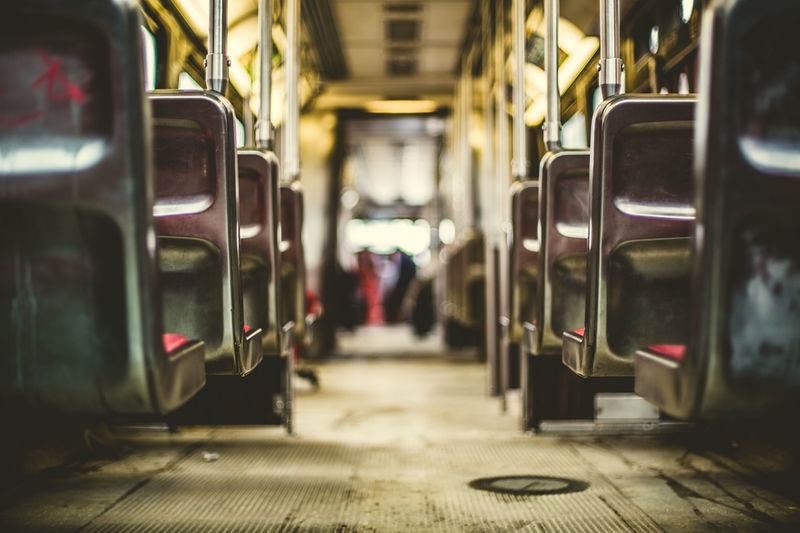
Rule 1: Never Check Luggage
Let me just repeat that one because it's so important: never check luggage.
Sure, it can be annoying to schlep luggage around the airport - but airports are designed to make that easy. Airports have smooth floors, wide spaces, and lifts and escalators for moving between levels. The tough part is manoeuvering luggage around on the street and on public transport, neither of which environments is designed around luggage. The thing is, though, you will have to do that part anyway once you have (with luck) retrieved your checked luggage.
Why take hand luggage? Simple: so that it doesn't get lost along the way. Nothing stresses me out more than the idea that I might arrive at my destination without clean clothes or toiletries, so I'd rather just have them on me. This goes double if you're travelling with kids: you need at least one change of clothes per child, nappies if the children are still using those, favourite toys and books, wipes, snacks, drinks, etc etc etc. Those items must be at hand at all times, during and after the journey, so you have to have them in hand luggage.
Bottom line, this means that you have your stuff with you even if you get delayed or rerouted suddenly, and there is no way that your luggage can end up in one place when you are in another. This already removes a major source of travel-related stress.
Rule 2: What Goes in the Luggage
The usual question I get at this point is "but how can you go away for a whole week with just that dinky suitcase?". Well, it takes planning and the right luggage, but it can be done. And no, I don't just show up wearing one of five identical black T-shirts or something like that! My typical work trip load-out looks like this:
-
Suit (a minimum of one suit per two days' wear)
-
Shoes for suit (you don't want to travel long-haul in suit shoes if you can avoid it)
-
Shirts (a minimum of one shirt per day; a spare shirt is good if you have room)
-
Ties, pocket squares, etc (even if you meet the same people wearing the same suit on subsequent days of a trip, if you change shirt, tie and pocket square, it comes off as a different outfit)
-
Sweater (one in the case in addition to the one you travel in - even if you don't have different trousers to change into, losing the tie and opening your collar in the evening helps to relax)
-
Toiletries (because they're going in hand luggage, these need to be sub-100ml - but these days, you can buy most things in travel sizes, and decant anything else)
I realise this is a bit male-centric, both in the talk of ties and the assumption that a single pair of shoes - well, two: one worn and one packed - can possibly be sufficient. This is my experience that I'm sharing here, though. I may try to get SWMBO to add her recommendations for women travellers at a later date.
On the topic of shoes, here's a pro tip: save space and protect your shoes by stuffing your underwear into the packed shoes. This will prevent the shoes from getting crushed and also free up the space that the underwear would have taken up inside the case. Just try to avoid mixing the "clean" shoe with the "dirty" one if you are on a multi-stop trip…
If I'm travelling for internal meetings, I probably won't bother with a suit & tie, but I'll have trousers and blazers instead, which take up at least as much room if not more.
It's all about the outfits, though: try to plan outfits that you can mix & match, so you wear a pair of jeans with your travel sneakers for informal activities, but dress up the same jeans with brogues, a shirt and a blazer for "business casual"1 events.
Bag of Holding
So what sort of Bag of Holding is all this going in? Just a standard-sized item of cabin luggage - you do NOT want to be That Guy (or Gal) arguing with gate staff about the size of your roll-aboard. Rigid sides are better for this purpose because they are less forgiving, so you are not tempted to stuff just one more sweater in there.
Make sure your case has TSA-compliant locks, just in case you do have to check it for whatever reason. Also, have a plan for your liquids and any other fragile or valuable items that are in your hand luggage and that you don't want to entrust to the tender mercies of the baggage handlers. A drawstring bag is good for this, as it takes up next to no room when empty, and can also be used for other purposes if necessary: keeping a wet swim suit apart from dry clothes, impromptu shopping trip, or whatever.
Remember also that not only do different airlines have different luggage restrictions, but there are also regional variations. The default IATA size for carry-on baggage is as follows:
Cabin baggage should have a maximum length of 56 cm (22 inches), width of 45 cm (18 inches) and depth of 25 cm (10 inches) including all handles, side pockets, wheels etc.
However, many airlines have smaller size restrictions, especially low-cost and regional operators, and some will also enforce weight limits aggressively. Regional carriers operating smaller planes under the aegis of a larger carrier will generally offer "valet" services for hand luggage, meaning that you leave it at the air stairs or on the jetway as you board the aircraft, and it is returned to you as you deplane. However, this still means that your luggage is going in the hold, so you should lock it and remove valuable or breakable items as if it were being checked in. Also, sometimes valet-checked luggage is returned at the carousel, not at the exit of the plane - check this ahead of time, as it may affect your planning if you have a connecting flight.
Rule 3: Get the Right Luggage
There are a few different categories of luggage worth owning if you travel at all frequently. Your mileage may vary, but these cover most bases.
The Overnight Bag
If you have to spend just one night on the road, it's not worth hauling an entire suitcase just for a change of shirt & underwear. My personal choice is a rolling laptop bag with a separate pocket, just big enough for that change of clothes. You can wear the same suit both days, and switch it up by changing ties and other accessories.
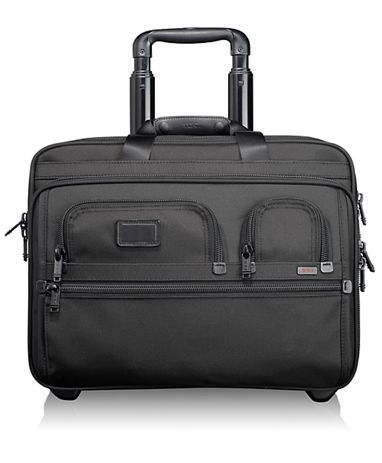
I own a previous generation of this bag from Tumi, and I love it. Others do the same sort of thing with a backpack, but then you need somewhere to put your clean clothes so they don't end up in a ball at the bottom of the backpack with a packet of last year's mints and a cable for a device you no longer own. However, I'm aware that I am prejudiced against the suit+backpack look, so if that combo works for you, more power to you.
The Basic Roll-Aboard
This is your generalist piece of luggage, that can serve for trips from two nights up to a week or so. Rigid versus soft sides is a matter of personal choice, but four-wheel "spinners" are a must. This way you can squeeze the case sideways through much tighter spaces, such as for instance the aisle of an aeroplane, instead of picking it up and banging all the other passengers on the elbows, knees, or even head.
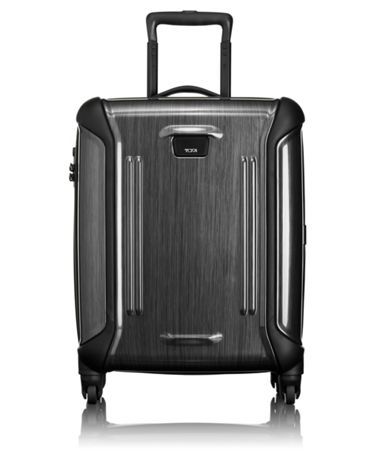
My personal choice is also from Tumi, but most manufacturers have something like this. Just one thing to point out is that there are two sizes of carry-on, and it pays to get the smaller one, sometimes labelled as the "international" version. There's no point in being able to fit more in your bag if you end up having to check it most of the time anyway.
The Duffel Bag (Optional)
A duffel bag is a very fashionable choice right now, but it's not super practical. It may look good in the departure lounge, but you may regret it if you have to hump the thing the length of FRA for your connection, or on that dreaded last day of the trip when you've already checked out of your hotel but your flight isn't for hours yet.
Why even list it then?
Because there are cases where a duffel bag is actually a sensible choice, and that is when you have chosen the correct one. I favour this one by North Face:
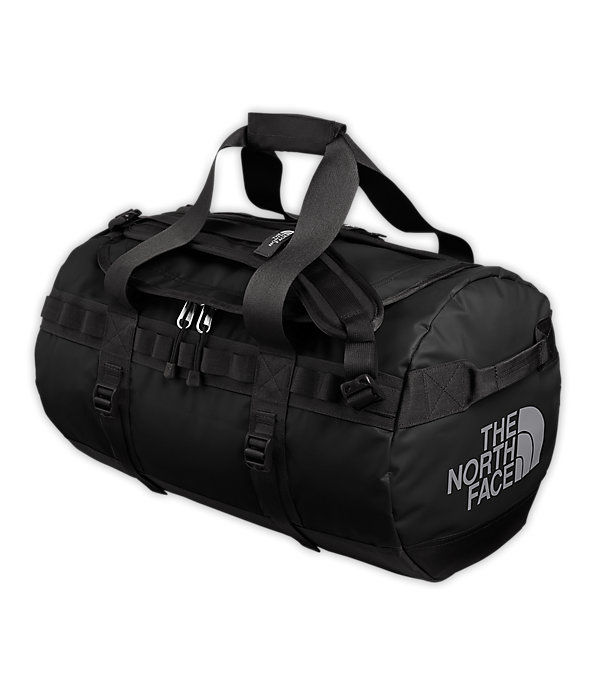
The point of this bag is that you can use it either as a rucksack or as a duffel bag. When it's a duffel it's rugged and waterproof - plonk it down on the snow if you need to, and your clothes will stay dry. Those loops on the outside are also super useful for hanging stuff onto with carabiners. The point of the rucksack straps, though, is that you can put it on your back and leave your arms free, which is especially great if you're travelling with children.
Duffel bags are subject to the same limitation that I was complaining about above with regard to backpacks: the contents tend to wind up all tangled together in a crumpled ball. To prevent that, I have a combination of packing cubes from Muji and Eagle Creek, but still, you're not going to pack a suit in one of these; it's strictly for informal trips or as your carry-on for family vacations. That's where this thing shines, in fact. You're almost certainly not going to get away with doing a family vacation with just carry-ons until your kids are quite a bit older than mine are now, so you're going to have to check some luggage - but pack one or two days' worth of essentials in one of these so that you are never separated from food, favourite toys, nappies, change of clothing, spare batteries, drawing materials, and all the other hundred and and one essentials of enjoying a family vacation and not getting lynched by the other passengers.
The Suit Bag (Optional)
This one definitely depends on your lifestyle and wardrobe - but if you need to wear a suit or similar formalwear at your destination more than rarely, you need one of these. Basically, the idea is that instead of folding your clothes, you just place them in the case, still on their hangers, secure them in place with a strap or two, zip up the case and off you go. At your destination, you can either hang the entire bag if you have a suitably sturdy wardrobe, or simply remove your clothes, still on their hangers, and hang them right up. While they won't be 100% fresh, they will be far less rumpled than if you'd folded them.
Once again, my own choice is from Tumi - the previous generation of this bag:
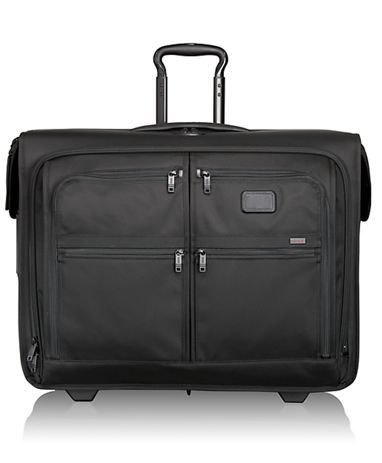
The thing is genius. If it does have one flaw, it's that it is pretty wide, so it can be unwieldy in airports where they have those width restrictions to stop people going through with their trolleys. It is still within IATA dimensions, although I've had to argue the point with gate agents a couple of times. Overall, the results are worth it though.
Other Notes
Hot / Cold
The hardest trips to plan for are the ones that involve multiple climates. The default is to take your outer coat on the plane, but that gets old fast, especially if you have connections & layovers. Instead, see if you can get away with a lighter-weight outer coat that you can pack, and layer it. One combo that works well is a sweater or a vest worn under a blazer, and a raincoat or similar over the top.
Cotton-cashmere blends are great for this purpose, and are also super-comfortable for travelling in - although I generally prefer to use older sweaters for this role, as sleeping in them is tough on their appearance.
You also need to plan your footwear, both socks and shoes. This may be specific to me, but I can deal with temperature extremes in other parts of my body much better than I can when they affect my feet. This is why I don't travel in emergency exit rows, despite the extra legroom - that, and not being able to keep my laptop bag handy.
Tetris
The enemy of efficient packing is space. No, this isn't some Zen paradox! Just don't leave empty spaces around your items, but instead figure out how to slot everything together like a jigsaw. This will both let you fit more stuff into the suitcase, and at the same time make sure that your stuff doesn't shift around in transit.
Some experience with Tetris is recommended.
Recap
Planning is everything. Get the right luggage - or an assortment of luggage to suit the types of trips you take. Sort out all your toiletries, medications, and so on. Ideally have travel-size duplicates that can just stay in their transparent baggie, ready to be dropped in your bag.
Same thing with clothes: plan an assortment of clothes that can be combined in different ways and that will cover the entire spectrum of expected climates on your trip. Yes, this can go wrong - ask me sometime about landing in New York in February, straight from the Caribbean, and being informed that my luggage had not made it.… This is why you also need a plan B, C, and several other letters (add more letters when travelling with kids).
With preparation and practice, you can pack in a few minutes, enjoy a stress-free trip, and arrive at your destination far less frazzled than someone who threw everything and the kitchen sink into a piece of luggage the size of the monolith from "2001".
Happy travels!
Update
I had no sooner published this post, than I found this list of "bad travel gear" from The Economist in my RSS queue.
The very first item in the list is:
Luggage with spinning wheels, which don't work well on rough surfaces and cost you precious overhead bin space.
Obviously I disagree with this one! Spinners have the advantage that they can roll in any direction - and if yours doesn't work on rough surfaces, I suggest you bought the wrong one. Mine works just fine on rough surfaces.
Much of the rest is common sense - items like money belts and travel wallets just mark you out as an inexperienced traveller. I do have an inflatable travel pillow because it takes up next to no room when deflated, but I rarely use it and should probably ditch it.
However, this item brought me up short:
Your tablet (unless it is your primary computer). Your phone and your laptop can do anything it can do. You don't need it. Leave it. If you want to read a magazine, buy The Economist in the airport.
Sorry, but this recommendation is even more bone-headed than the "no spinners" one above. Maybe this is true if you're in business class, with plenty of room and in-seat power, but at the back of the plane where we plebes travel, there is rarely enough room to get out even a 13" laptop. A phone on the other hand has a much smaller screen, so while it's probably fine for a short-haul trip, your eyes would get very tired of squinting at the screen for a long trip. Also, my iPad has a case that lets it stand upright so I can watch a film or just rest my arm while reading; my iPhone doesn't, because most of the time that stand would just be useless extra bulk in my pocket. The iPad's case also means that the device can be stood on its edge on the tray together with my dinner, while I'd have to close the laptop to eat - and then I couldn't read or watch my film. If I had bought that paper copy of The Economist - because I hate trees or something - I'd be trying to read it one-handed while eating, a sure-fire recipe for ending up wearing your dinner.
Let's also talk about battery life: I have never completely zero'd the battery on my iPad on even the longest trips - and if it comes to that, I have external battery packs in my bag (note plural). If you watch movies on your laptop, just one will take a huge bite out of your power reserve. If you try to actually use a laptop, things can also go south surprisingly fast. For instance I have one corporate Word template which just makes Word craaazy for some unfathomable reason, and it starts thrashing for the whole time any doc using that template is open.
For once, I can't agree with Gulliver and The Economist. Unless it's a short-haul flight - meaning, an hour's duration or so - you almost certainly want your tablet with you on the trip.
Image by Matthew Wiebe via Unsplash
-
The most infuriatingly loose specification ever. Just say "jeans & sneakers okay" or "chinos & polo shirts" or whatever. "Business casual" is too context-dependant to be useful unless you already know. ↩
PSA
Transit lounges of international airports are not places where you can assume no one understands your language, no matter how obscure. It's amazing what people are happy to discuss out loud.
Out with the old, in with the new!
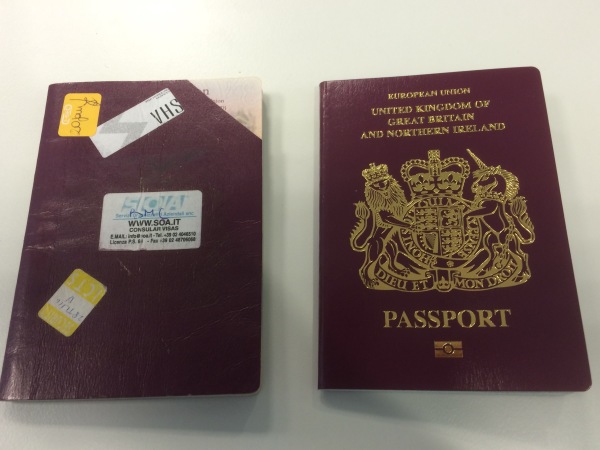
When I got my old passport I was living in a different country, I had not even asked my wife to marry me, and I had no idea of the many wonderful ways in which children can upend your life…
Since then, I asked my then-girlfriend to marry me, moved to another country, bought a house, married my lovely wife, had a wonderful little boy, moved house again, and had a delightful little girl. The passport accompanied me on my honeymoon and on many many business trips. It contains stamps from (in page order) Morocco, USA, Turkey, Bahamas, Anguilla, Cayman Islands, Israel, South Africa, Singapore, Russia, Saudi Arabia1, Australia, UAE, and St Maarten.
Now I have to unlearn the old numbers and start to make friends with the new passport. First trip will be to the USA in ten days' time!
-
Yes, both Saudi Arabia and Israel in the same passport. The trick is to do it in the right order2: go to Saudi Arabia first, because they won't even let you in with an Israeli stamp in your passport. Then for a palate-cleanser, go to Israel, where the most reaction I got when I presented my passport with the Saudi stamp at Ben-Gurion was a raised eyebrow. ↩
-
In point of fact I would argue that the correct order would be not to go to "Saudi" Arabia at all, and just spend time in Israel instead. I love travelling, and I generally find something good everywhere I go: the people, the climate, the landscape, the art, the architecture, the music, the food - something! Saudi Arabia is the first place to score a perfect zero in every single column. Israel, on the other hand, scores very highly in all categories. I will be very happy if I can avoid getting any Saudi stamps in my new passport for its entire decade of validity. ↩
Air… BUS?
What's in a name?
Airbus is in the news, and analysts doubt that the company will pull ahead of its archrival Boeing.
I have only the most indirect relationship with the aerospace industry - basically, I fly a fair amount - but the whole idea of Airbus is off-putting to me. Airbus is a conglomerate of interesting companies that manages to be far less cool than the sum of its parts. Even the name implies disdain for its customers. Air… BUS? I don't want a "bus" experience of air travel, and I don't like the association of those ideas.
Even the logo manages to be desperately uncool and off-putting:

Compare and contrast with one of the constituent companies:

Could there be a more awesome name than "Aérospatiale"? The logo is pretty cool as well, although a bit retro now.
Since we're on the topic, let's talk about Boeing as well for a moment:

Another cool logo, reminding us that Boeing is not just about a big bus that takes passengers between cities, but also about rockets that go to space.
This is not just theoretical marketing won
kery, either. The whole concept of the big A380 "super-jumbo"1 fits into that bus model of thinking: not the fastest, not the most innovative, just a way to stack as much self-loading cargo
as possible
in one bus and ship it to its destination as cheaply as possible (for the operator). This concept has largely failed to resonate with the market, and the A380 programme is in serious trouble, with Reuters calling it ["poor-selling"](http://www.reuters.com/article/2015/01/13/us-airbus-orders-idUSKBN0KM0VO20150113 "
Airbus to juggle jet production, defends poor-selling A380" ). Compare and contrast with the Concorde, which is still used as an image of technological success years after the termination of maintenance contracts - by Airbus - killed it as a commercial proposition.
I mean, just look at it!
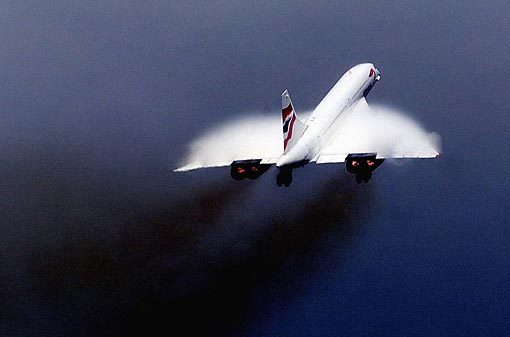
Nobody is going to sell posters of the A380 after the end of its service life. No airport will want to park one on its apron, and no travellers will gaze at it longingly from the windows of their more pedestrian aircraft.
What's in a name? Sometimes, everything.
-
Surely it says something that they even define themselves in relation to categories that are already owned and defined by their arch-rival? There is only one "jumbo" jet, and that is the Boeing 747. Calling your own plane the "super-jumbo" just makes you look like Homer Simpson designing a car. Maybe they should just call the next one the "Airbus Homer", with gratuitous fins, bubble domes everywhere, and shag carpeting throughout the cabin. ↩
Lie ^W Sit back
It seems someone has actually called for "revolt on reclining seats in planes". The battle over reclining seats has been going on a long time, but revolt seems a tad excessive...
I'd be happy if we could agree not to recline until meal service is done, but as long as we’re revolting:
Smoking in flight has been forbidden as long as I can remember. What if airlines were to repurpose the redundant no-smoking lights to indicate when it's okay to recline? This way people could also move their laptops out of the way, and so on. My iPad was nearly crushed when the person in front decided to recline suddenly and violently. Only the magnet on the Smart Cover releasing saved it from a cracked screen. I have also seen people ending up wearing their dinner or their drinks when the person in front reclined sharply.
Once I was even told to stop poking my knees into the back of the person in front. My suggestion that moving her seat forward would solve that problem nicely was met with a stony glare, but I literally had nowhere else to go.
If you’re this worked up over conditions in flight, though, may I suggest either ordering another drink, or springing for the upgrade? Premium Economy isn’t that much more expensive, and there is significantly more room, bigger screens, earlier service, and so on. The one downside is it’s often placed at the front of the Economy section, so it ends up being over the wings without much of a view out.
Travel mysteries
I like to fly in window seats. Despite all the flying I do, I still enjoy looking out the window and seeing the world go by.
One downside though is when it comes to deplaning. There is a certain class of passenger who will storm up the aisle, barging past passengers in window seats (me) trying to get out into the aisle.
Now if they were in a hurry to get to their meeting or make a connection I would understand. I've been there often enough myself. What I don't get is when after aggravating half the plane to be first out, they then stroll along the jetway, seemingly without a care in the world, while all the passengers they
blocked overtake them...
May their beds always be full of crumbs, and may a family pet make a mess in their favourite slippers - that they only discover after putting on the footwear in question.
